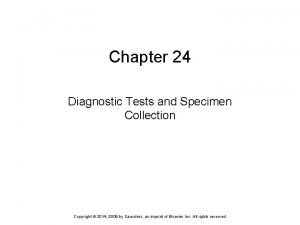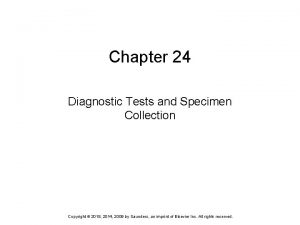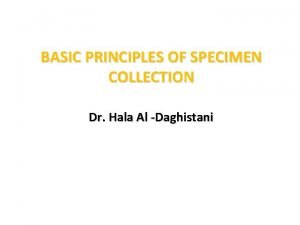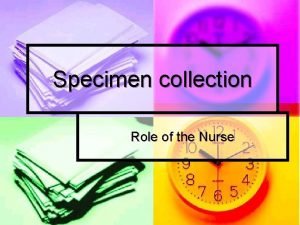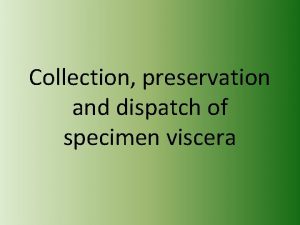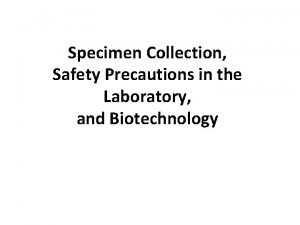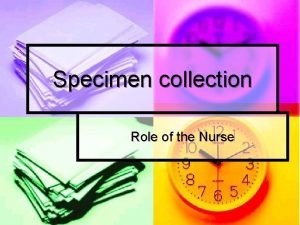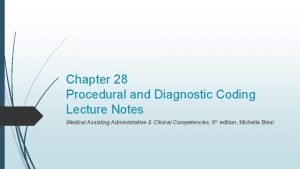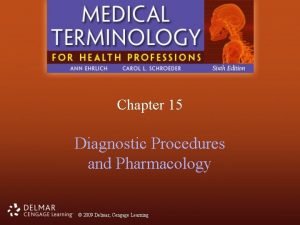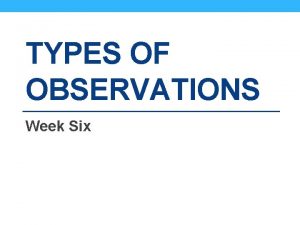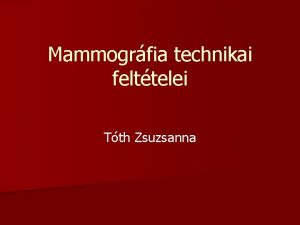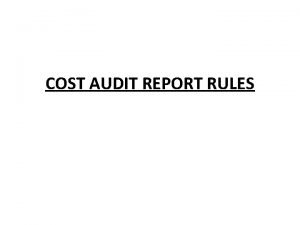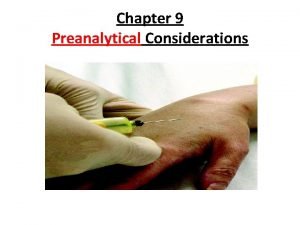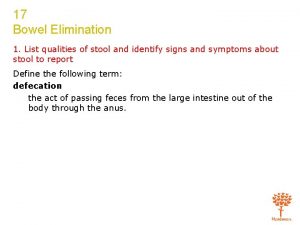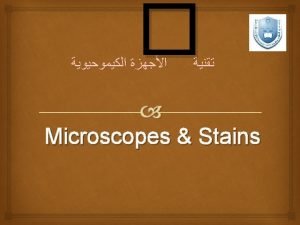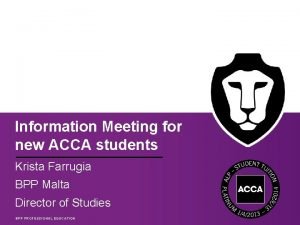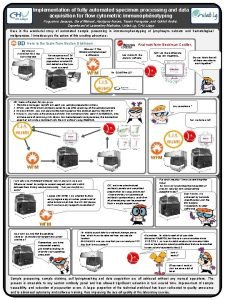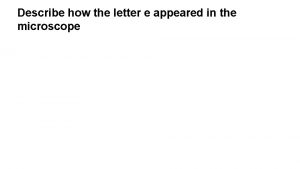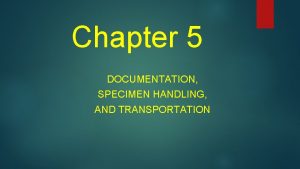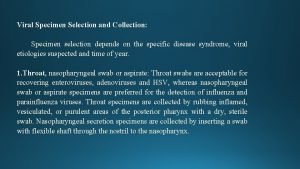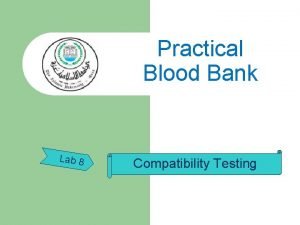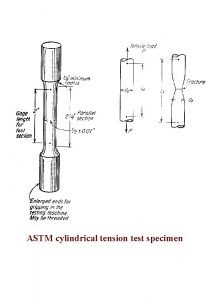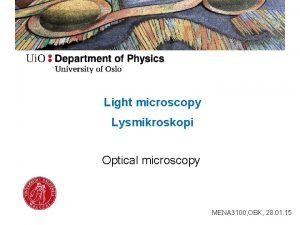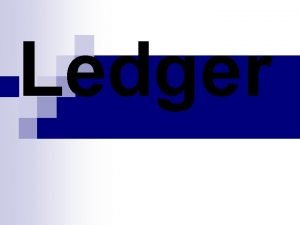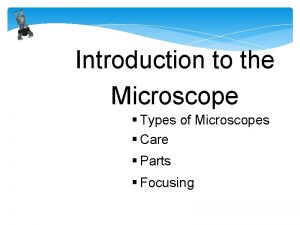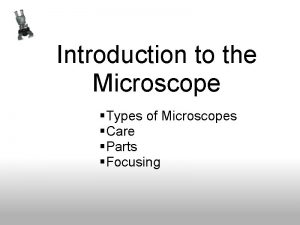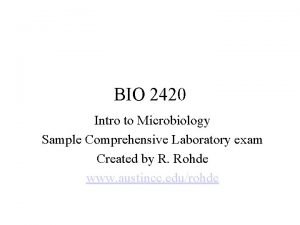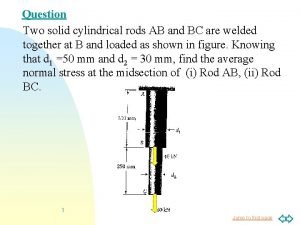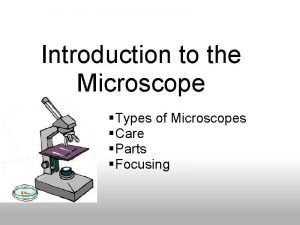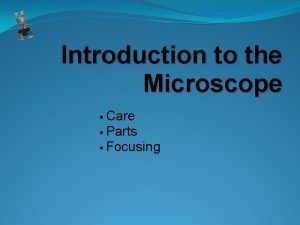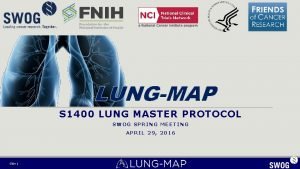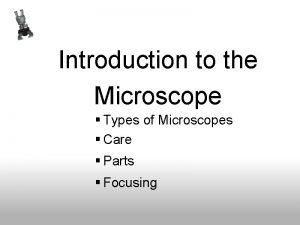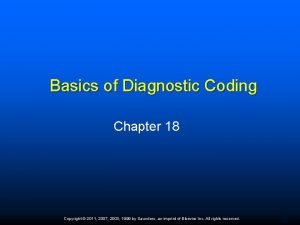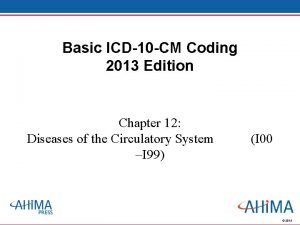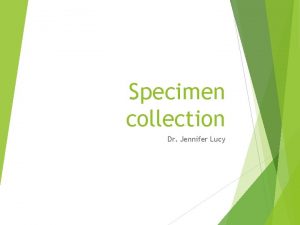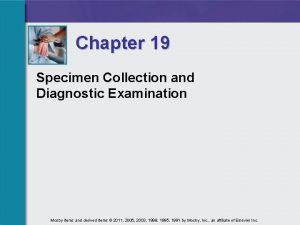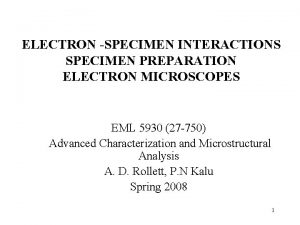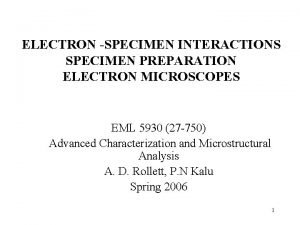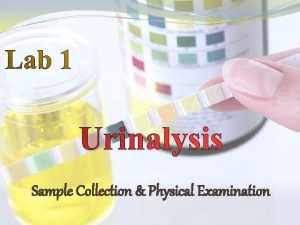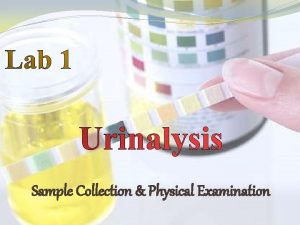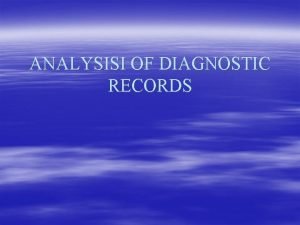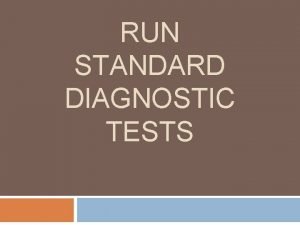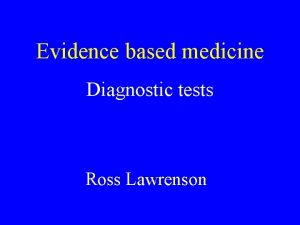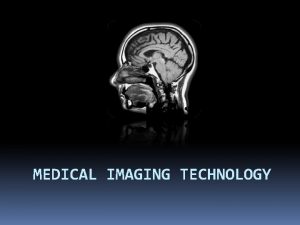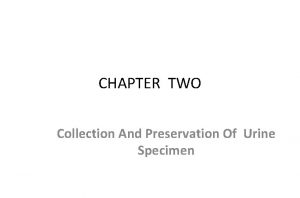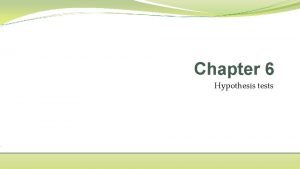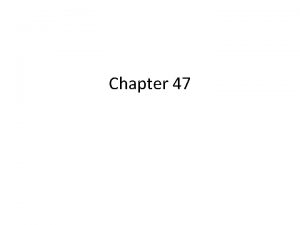Chapter 24 Diagnostic Tests and Specimen Collection Copyright



















































- Slides: 51

Chapter 24 Diagnostic Tests and Specimen Collection Copyright © 2018, 2014, 2009 by Saunders, an imprint of Elsevier Inc. All rights reserved.

Lesson 24. 1 Overview of Diagnostic Tests Part 1 Theory 1) Discuss appropriate psychosocial care and education for patients undergoing diagnostic tests or procedures. 2) 3) Prepare to perform a capillary glucose test, a venipuncture, a throat culture, an electrocardiogram, a urine dipstick test, and a stool for occult blood test. Describe each of the categories of tests that are commonly performed. Copyright © 2018, 2014, 2009 by Saunders, an imprint of Elsevier Inc. All rights reserved.

Lesson 24. 1 Overview of Diagnostic Tests Part 1 Clinical Practice 1) Provide pretest and post-test nursing care, including appropriate education, for patients undergoing diagnostic tests and procedures. 2) Attend to psychosocial concerns of patients undergoing various diagnostic tests. 3) Perform a random blood glucose test using capillary blood and a glucometer. Copyright © 2018, 2014, 2009 by Saunders, an imprint of Elsevier Inc. All rights reserved.

Diagnostic Testing and the Nursing Process When diagnostic tests are ordered, the nurse should: Assess what the patient knows about the test Ø Determine any special nursing measures needed to protect the safety of the patient Ø Assess wounds each shift for signs of infection Ø Assess the patient for allergies to medication and to iodine Ø Copyright © 2018, 2014, 2009 by Saunders, an imprint of Elsevier Inc. All rights reserved.

Diagnostic Testing and the Nursing Process (cont’d) Nursing diagnosis Impaired urinary elimination related to dysuria and foul-smelling urine Ø Pain related to raw, sore throat Ø Pain related to inflammation and swelling at wound site Ø Copyright © 2018, 2014, 2009 by Saunders, an imprint of Elsevier Inc. All rights reserved.

Diagnostic Testing and the Nursing Process (cont’d) Planning Verify that items needed are on hand Ø Ensure that pretest medications are available Ø Prepare to do patient teaching Ø Prepare for treatments such as enemas or IV starts Ø Expected outcomes are written for the particular nursing diagnosis associated with the problem for which the test is being performed Ø Copyright © 2018, 2014, 2009 by Saunders, an imprint of Elsevier Inc. All rights reserved.

Diagnostic Testing and the Nursing Process (cont’d) Implementation Make certain that the patient has received adequate teaching about the test or procedure to be performed Ø Carry out the pre- and post-test actions for the particular test or procedure ordered Ø Obtain a signed consent for any invasive procedure requiring one Ø Copyright © 2018, 2014, 2009 by Saunders, an imprint of Elsevier Inc. All rights reserved.

Diagnostic Tests Provide information about chemical reactions affecting physiologic functioning of the body Enable examination of blood, urine, and other body fluids, which provides clues about the functioning of various organs, body systems, and mechanisms Used to confirm diagnosis and guide treatment Provide information concerning changes in a patient’s condition Copyright © 2018, 2014, 2009 by Saunders, an imprint of Elsevier Inc. All rights reserved.

Laboratory Tests: Hematology The study of blood and its components Complete blood count (CBC) Ø Hematocrit Ø The separation of blood and the amount of blood cells in relation to the amount of plasma Hemoglobin Ø Information about state of health or presence of illness Capacity of blood to transport oxygen from lungs to tissues Platelets Ø Essential to blood clotting Copyright © 2018, 2014, 2009 by Saunders, an imprint of Elsevier Inc. All rights reserved.

Laboratory Tests: Hematology (cont’d) During infection, the number and type of white blood cells increase Neutrophil counts can be significant In severe infections, bone marrow releases more granulocytes Immature polymorphonuclear neutrophils are released (called bands) The result is a shift to the left (more bands) Copyright © 2018, 2014, 2009 by Saunders, an imprint of Elsevier Inc. All rights reserved.

Laboratory Tests: Hematology (cont’d) Drug therapy may cause leukopenia (a decrease in leukocytes) Hemoglobin shows the capacity of the blood to transport oxygen from the lungs to the tissues A normal platelet count is essential to clotting Warfarin therapy is guided by prothrombin time (reported in INR numbers) The erythrocyte sedimentation rate (ESR) gives clues about inflammatory conditions Copyright © 2018, 2014, 2009 by Saunders, an imprint of Elsevier Inc. All rights reserved.

Laboratory Tests: Blood Chemistry Tests To detect changes in biochemical reactions in the body and determine a diagnosis Blood glucose tests Ø Bilirubin, alanine aminotransferase (ALT), and alkaline phosphatase (ALP) Ø Used to measure liver function Blood urea nitrogen (BUN) and creatinine levels Ø Essential in the diagnosis and control of diabetes Important indicators of kidney dysfunction Lactate dehydrogenase (LDH), creatine kinase (CK), and aspartate aminotransferase (AST) Ø Detect damage to striated and heart muscle Copyright © 2018, 2014, 2009 by Saunders, an imprint of Elsevier Inc. All rights reserved.

Laboratory Tests: Blood Chemistry Tests (cont’d) Some institutions use automated computerized blood chemistry testing Examples of tests available Serum albumin, ALP, AST Ø Total bilirubin, serum calcium, cholesterol, glucose, LDH, phosphate, total protein, BUN, uric acid Ø Copyright © 2018, 2014, 2009 by Saunders, an imprint of Elsevier Inc. All rights reserved.

Laboratory Tests: Blood Glucose Blood glucose commonly performed at the bedside or in physician’s office by the nurse Guides insulin therapy for diabetics Guidelines for performing test depend on manufacturer of testing equipment Requires a fingerstick to obtain capillary blood Review Skill 24 -2 Copyright © 2018, 2014, 2009 by Saunders, an imprint of Elsevier Inc. All rights reserved.

Laboratory Tests: Serology Tests Based on analysis of serum Used to diagnose both viral and bacterial diseases or determine antibody levels for: Ø Also used to determine titers in response to vaccines Radioimmunoassays Ø Dysentery, rheumatic fever, typhoid, influenza, rubella, and syphilis Detect minute particles of protein in the blood Blood typing and identification of blood factors may also be carried out in the serology section of the laboratory Copyright © 2018, 2014, 2009 by Saunders, an imprint of Elsevier Inc. All rights reserved.

Laboratory Tests: Serology Tests (cont’d) Examples of serology tests ordered Agglutination test for specific organisms Ø Antistreptolysin-O titer Ø Blood typing: ABO groups and Rh Ø Carcinoembryonic antigen assay (CEA) Ø Coombs’ test Ø C-reactive protein antiserum Ø Heterophil antibody titer Ø Tests for syphilis Ø Copyright © 2018, 2014, 2009 by Saunders, an imprint of Elsevier Inc. All rights reserved.

Laboratory Tests: Urinalysis Provides information about kidney function or other body functions and diseases Urine deteriorates quickly and should be tested soon after collection Urine composition varies according to fluid intake and diet Urine specimens can be classified as: Single, catheterized, or random specimens Ø Midstream specimens Ø Timed, long-period specimens Ø Copyright © 2018, 2014, 2009 by Saunders, an imprint of Elsevier Inc. All rights reserved.

Laboratory Tests: Urinalysis (cont’d) Midstream collections External genitalia are cleansed Ø A small amount of urine is passed Ø Urine is collected from midstream voiding in a sterile container Ø Used for cultures when a bladder infection is suspected Ø Copyright © 2018, 2014, 2009 by Saunders, an imprint of Elsevier Inc. All rights reserved.

Laboratory Tests: Urinalysis (cont’d) Timed, long-period specimens Collected over 12 - or 24 -hour period Ø Container may be kept on ice and has some form of preservative Ø Used to determine kidney function and possible glomerulonephritis or acute tubular necrosis Ø Copyright © 2018, 2014, 2009 by Saunders, an imprint of Elsevier Inc. All rights reserved.

Other Laboratory Tests Bacteriology Blood, urine, feces, wound drainage, and other body fluids or tissues cultured to identify the disease-causing organism Ø Aseptic technique must be maintained when collecting specimens for culture and sensitivity Ø Histology and cytology tests The study of tissues and cells Ø Detect carcinogenic, metabolic, vascular, and other changes Ø Ova and parasites Cultures from specimens of feces, blood, urine, wound drainage, or samples of body tissue or fluids Copyright © 2018, 2014, 2009 by Saunders, an imprint of Elsevier Inc. All rights reserved.

Question 1 Which of the following is a nursing diagnosis used when the patient needs teaching regarding diagnostic tests? 1) 2) 3) 4) Impaired verbal communication related to changes in the mind Readiness for enhanced communication related to impaired vision Deficient knowledge related to diagnostic tests Impaired verbal communication related to hearing aids Copyright © 2018, 2014, 2009 by Saunders, an imprint of Elsevier Inc. All rights reserved.

Question 2 Which of the following tests is commonly performed to detect changes in biochemical reactions in the body and to determine a diagnosis? 1) 2) 3) 4) Hematology test Blood chemistry test Urinalysis Serology test Copyright © 2018, 2014, 2009 by Saunders, an imprint of Elsevier Inc. All rights reserved.

Lesson 24. 2 Overview of Diagnostic Tests Part 2 Theory 3) Describe each of the categories of tests that are commonly performed. (Continued) Clinical Practice 4) Perform patient teaching for a magnetic resonance imaging (MRI) test. Copyright © 2018, 2014, 2009 by Saunders, an imprint of Elsevier Inc. All rights reserved.

Ultrasonography Records the reflection of sound waves directed into the tissues Used to diagnose pathologic conditions of: Ø Uterus, ovaries, prostate, heart, liver, kidneys, pancreas, gallbladder, lymph nodes, thyroid, eyes, and peripheral blood vessels Often used in conjunction with nuclear medicine scans Copyright © 2018, 2014, 2009 by Saunders, an imprint of Elsevier Inc. All rights reserved.

Radiology Procedures Produce data to be used in diagnosis X-ray: most common Ø Fluoroscopy: examines movement Ø Produces image of the denser tissues by passing rays through the part to expose a film X-rays passed through the body part and projected on a fluorescent screen Cineradiography Ø Adding a video camera to the fluoroscope equipment and making a photographic record of the procedure Copyright © 2018, 2014, 2009 by Saunders, an imprint of Elsevier Inc. All rights reserved.

Radiology Procedures (cont’d) Commonly performed radiology procedures Chest x-ray Ø Barium swallow and upper GI series Ø KUB (kidneys, ureters, and bladder) Ø Gallbladder series Ø Copyright © 2018, 2014, 2009 by Saunders, an imprint of Elsevier Inc. All rights reserved.

Radiology Procedures (cont’d) IVP (intravenous pyelogram) X-ray of bony skeleton Arthrogram Myelogram Radionuclide scan Computed tomography (CT) scan Copyright © 2018, 2014, 2009 by Saunders, an imprint of Elsevier Inc. All rights reserved.

Radionuclide Scans Various organs and soft tissues of the body attract and concentrate certain radionuclides A radioactive substance is injected into a vein After organ being scanned absorbs the substance, a radioactivity scanner (scintillator) is passed over the area where the organ is located Copyright © 2018, 2014, 2009 by Saunders, an imprint of Elsevier Inc. All rights reserved.

Computed Tomography Computer enhances x-rays and allows examination of horizontal sections of the body at various angles to define tissue density Most CT scans noninvasive, but consent may be required for scans using a contrast medium Data fed into the computer, which produces images in shades of gray that indicate the different densities of the organ Copyright © 2018, 2014, 2009 by Saunders, an imprint of Elsevier Inc. All rights reserved.

Magnetic Resonance Imaging Noninvasive method of differentiating normal from abnormal tissue in the body Commonly used for the brain, knee joint, spine and spinal cord, and abdominal organs Patients with metal devices implanted in the body cannot undergo this procedure because the machine emits a strong magnetic field Contraindicated in patients with hip prostheses, implanted pacemakers or defibrillators, artificial cardiac valves, or vascular clips or staples from recent surgery Copyright © 2018, 2014, 2009 by Saunders, an imprint of Elsevier Inc. All rights reserved.

Magnetic Resonance Imaging (cont’d) Patient teaching is very important before this procedure; patient needs to know the duration of the test and that it requires being in a noisy environment Patient may become claustrophobic during test Patient needs to know deep-breathing and relaxation techniques Copyright © 2018, 2014, 2009 by Saunders, an imprint of Elsevier Inc. All rights reserved.

Positron Emission Tomography Scans Noninvasive test used to diagnose cancer, heart disease, and some brain disorders PET scan produces digital pictures that show abnormal cells in the body. PET scan shows differences in blood flow and oxygen uptake in cells Problems can be identified earlier with PET than with CT or MRI Copyright © 2018, 2014, 2009 by Saunders, an imprint of Elsevier Inc. All rights reserved.

Cardiopulmonary Studies EKG/ECG Diagnoses heart rhythms and heart disease; measures electrical activity of the heart Consists of waves and lines that represent the electrical activity during the cardiac cycle P waves, QRS complex, and T wave Ø The person trained in interpreting the tracing can determine if the waves are normal or abnormal Electrodes are applied to the skin Vessels can be detected, as can valvular dysfunction Copyright © 2018, 2014, 2009 by Saunders, an imprint of Elsevier Inc. All rights reserved.

Cardiopulmonary Studies (cont’d) Cardiac catheterization Determines function of heart, valves, coronary circulation Ø Readings taken of oxygen concentration at different sites, of pressure in different heart chambers, and cardiac output Ø Abnormal blood flow through the heart and the coronary vessels can be detected Ø A surgical procedure using surgical aseptic techniques Ø Copyright © 2018, 2014, 2009 by Saunders, an imprint of Elsevier Inc. All rights reserved.

Cardiopulmonary Studies (cont’d) Angiography and arteriography Locate lesions, occluded vessels, tumors, and malformed blood vessels Ø Contrast medium injected into an artery and x-rays taken of the dye spreading through the vessels Ø Used to diagnose problems in arteries anywhere in the body: heart, neck, brain, or extremities Ø Copyright © 2018, 2014, 2009 by Saunders, an imprint of Elsevier Inc. All rights reserved.

Cardiopulmonary Studies (cont’d) Treadmill stress test Measures the cardiac heart rate and blood pressure response to clinically controlled active exercise Ø Used to diagnose heart capacity, to guide convalescence from a myocardial infarction, and to determine response to medical treatment Ø While having heart action continuously monitored by ECG, the patient walks on a treadmill, pedals a stationary bicycle, or climbs a set of stairs Ø Copyright © 2018, 2014, 2009 by Saunders, an imprint of Elsevier Inc. All rights reserved.

Cardiopulmonary Studies (cont’d) Pulmonary function test (PFT) Provides information about respiratory function, lung capacity, and diffusion of gases Ø Spirometers and other breathing devices may be used Ø No special preparation is required Ø Copyright © 2018, 2014, 2009 by Saunders, an imprint of Elsevier Inc. All rights reserved.

Question 3 Which of the following diagnostic tests is a noninvasive method of visualizing soft tissue structures of the body? 1) 2) 3) 4) Ultrasonography X-rays Magnetic resonance imaging (MRI) Computed tomography Copyright © 2018, 2014, 2009 by Saunders, an imprint of Elsevier Inc. All rights reserved.

Question 4 Melissa’s patient is going for an electrocardiogram. Her patient is scared and wants Melissa to explain the procedure. Which best describes an electrocardiogram? An ECG is a: 1) 2) 3) 4) record of the electrical activity of the heart. record of the position and motion of the heart produced by ultrasound waves. graphic record of the heart sounds. record of the direction and magnitude of the forces of the heart during one heartbeat. Copyright © 2018, 2014, 2009 by Saunders, an imprint of Elsevier Inc. All rights reserved.

Lesson 24. 3 Overview of Diagnostic Tests Part 3 Theory 3) Describe each of the categories of tests that are commonly performed. (Continued) 4) Explain factors to be considered when an older adult is to undergo diagnostic testing. Copyright © 2018, 2014, 2009 by Saunders, an imprint of Elsevier Inc. All rights reserved.

Lesson 24. 3 Overview of Diagnostic Tests Part 3 Clinical Practice 5) Describe how to prepare a patient for and assist with aspiration procedures such as lumbar puncture, thoracentesis, paracentesis, bone marrow aspiration, and liver biopsy. 6) Correctly use Standard Precautions whenever obtaining or handling specimens for diagnostic tests. 7) List the steps for assisting with a pelvic examination and Pap test. 8) Correctly fill out laboratory and test requisition forms. Copyright © 2018, 2014, 2009 by Saunders, an imprint of Elsevier Inc. All rights reserved.

Gastroscopy Visual inspection of upper digestive tract and stomach Obtain specimens of gastric contents and perform a biopsy on the stomach tissues Local anesthetic is sprayed on the pharynx, and a gastroscope is passed to the stomach The scope has a fiberoptic system for its lens Gastroscope may be equipped with a camera to take color photographs Washings to obtain specimens for cytology studies or a biopsy specimen is taken Copyright © 2018, 2014, 2009 by Saunders, an imprint of Elsevier Inc. All rights reserved.

Proctosigmoidoscopy Visual inspection of the lower bowel to check the lining for ulceration, polyps, tumors, inflammation, and other abnormalities The sigmoidoscope is inserted The fiberoptic lens enables examiner to see the structures; suction can remove secretions Air may be introduced to inflate the lower bowel to better view the wall, and biopsy forceps may be used to remove a tissue specimen Copyright © 2018, 2014, 2009 by Saunders, an imprint of Elsevier Inc. All rights reserved.

Colonoscopy Inspection of the entire large intestine for polyps, areas of inflammation, and malignant lesions A long, flexible fiberoptic endoscope is inserted anally and slowly advanced through the large intestine Should not be done sooner than 10 to 14 days after barium GI studies Copyright © 2018, 2014, 2009 by Saunders, an imprint of Elsevier Inc. All rights reserved.

Cystoscopy Visual inspection of the interior of the bladder Collection of biopsy specimens, collection of urine separately from each ureter, and treatment of various conditions Cystoscope passed through the urethra and the bladder is visually inspected Copyright © 2018, 2014, 2009 by Saunders, an imprint of Elsevier Inc. All rights reserved.

Endoscopic Retrograde Cholangiopancreatography Used to identify a cause of biliary obstruction such as stricture, cyst, stones, or tumor Endoscope is inserted through the mouth and into the duodenum after intravenous sedation A catheter is inserted into the pancreatic duct via the endoscope and a contrast medium is injected X-rays are taken Copyright © 2018, 2014, 2009 by Saunders, an imprint of Elsevier Inc. All rights reserved.

Aspirations To obtain bone marrow, liver cells, spinal fluid, abdominal fluid, or fluid in the chest cavity Usually performed at the bedside or in a procedure room by the physician Essential that the patient remain still during the procedure Copyright © 2018, 2014, 2009 by Saunders, an imprint of Elsevier Inc. All rights reserved.

Electroencephalography Tracing of the brain waves Neurologic and physiologic activity produces electrical charges measured as brain waves Localize and diagnose brain lesions, scars, epilepsy, infections, blood clots, and abscesses Also to determine brain death in comatose patients on life support systems Electrodes attached to scalp with skin glue or paste, or a mesh cap containing the 19 to 25 electrodes is placed on the head Copyright © 2018, 2014, 2009 by Saunders, an imprint of Elsevier Inc. All rights reserved.

Other Diagnostic Tests Blood specimens Wound or throat culture Random blood sugars Hemoglobin levels Urine dips Papanicolaou smears Copyright © 2018, 2014, 2009 by Saunders, an imprint of Elsevier Inc. All rights reserved.

Diagnostic Testing and the Older Adult Older patients often react differently to invasive tests Older adults often have several problems that may interfere with doing the procedure Always ask older adults if they have questions or need special accommodations Copyright © 2018, 2014, 2009 by Saunders, an imprint of Elsevier Inc. All rights reserved.

Question 5 Melissa’s patient now needs an aspiration. She is very nervous about this procedure as well. Melissa explains to her patient that an aspiration is performed by: 1) 2) 3) 4) a flexible fiberoptic instrument. injecting a needle into the abdomen. extracting fluid or tissue from the patient. inserting a needle through the chest wall into the pleural space to remove air. Copyright © 2018, 2014, 2009 by Saunders, an imprint of Elsevier Inc. All rights reserved.
 Chapter 23 specimen collection and diagnostic testing
Chapter 23 specimen collection and diagnostic testing Chapter 24 diagnostic tests and specimen collection
Chapter 24 diagnostic tests and specimen collection Principles of collection of specimen
Principles of collection of specimen Nurses responsibility in collection of urine specimen
Nurses responsibility in collection of urine specimen Preservation of viscera
Preservation of viscera Safety precautions in blood collection
Safety precautions in blood collection Nurses responsibility during specimen collection
Nurses responsibility during specimen collection Ace different tests help iq tests
Ace different tests help iq tests Landsat collection 1 vs collection 2
Landsat collection 1 vs collection 2 Documents against payment
Documents against payment Each e/m code description identifies the
Each e/m code description identifies the Chapter 15 diagnostic procedures and pharmacology
Chapter 15 diagnostic procedures and pharmacology Chapter 20 more about tests and intervals
Chapter 20 more about tests and intervals Event samples observations
Event samples observations Specimen of tagal folklore
Specimen of tagal folklore Specimen mammográfia
Specimen mammográfia What is cost audit
What is cost audit Pre-analytical considerations in phlebotomy
Pre-analytical considerations in phlebotomy London specimen
London specimen Aqa economics paper 3
Aqa economics paper 3 Chapter 17 bowel elimination
Chapter 17 bowel elimination Compound microscope
Compound microscope Ifr cbe specimen
Ifr cbe specimen Aurore tassin
Aurore tassin Specimen record observation
Specimen record observation Letter e drawing
Letter e drawing Documentation of specimen in laboratory
Documentation of specimen in laboratory Specimen selection
Specimen selection Identify the specimen
Identify the specimen Exchange transfusion blood group selection
Exchange transfusion blood group selection How is the dna separated into single strands
How is the dna separated into single strands Tension test
Tension test In sem, magnefied image of specimen is obtained on
In sem, magnefied image of specimen is obtained on Specimen of ledger
Specimen of ledger Types of microscopes
Types of microscopes Different types of microscope and their uses
Different types of microscope and their uses Specimen dish
Specimen dish Specimen of general crossing
Specimen of general crossing Specimen name
Specimen name Debit note and credit note
Debit note and credit note Two solid rods labeled a and b
Two solid rods labeled a and b Specimen voucher
Specimen voucher Sales contract contoh
Sales contract contoh When focusing a specimen you should always start with the
When focusing a specimen you should always start with the When focusing a specimen you should always start with the
When focusing a specimen you should always start with the Ddo specimen signature form
Ddo specimen signature form Swog specimen tracking
Swog specimen tracking Three types of microscope
Three types of microscope Chapter 18 diagnostic coding
Chapter 18 diagnostic coding Chapter 12 basics of diagnostic coding
Chapter 12 basics of diagnostic coding The seven s's of crime scene investigation
The seven s's of crime scene investigation Multitester
Multitester
